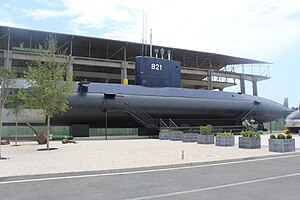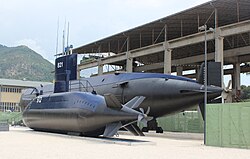 Heroj (P-821) in the Porto Montenegro Museum. Heroj (P-821) in the Porto Montenegro Museum.
| |
| Class overview | |
|---|---|
| Builders | Brodogradilište specijalnih objekata (BSO), Split, SR Croatia, SFR Yugoslavia |
| Operators | |
| Preceded by | Sutjeska class |
| Succeeded by | Sava class |
| Built | 1964–1970 |
| In commission | 1968–late 1990s |
| Completed | 3 |
| General characteristics | |
| Displacement |
|
| Length | 50.4 m (165 ft) |
| Depth | 210 m (689 ft 0 in) |
| Propulsion |
|
| Speed |
|
| Range | 4,100 nmi (7,593 km; 4,718 mi) at 10 knots (19 km/h; 12 mph) |
| Complement | 28 |
| Armament |
|
The Heroj class (English: Hero) was a class of diesel-electric attack submarines built for the Yugoslav Navy during the 1960s. The three strong class was the second generation of domestically built submarines, representing a significant improvement compared to the earlier Sutjeska class. Built at the Brodogradilište specijalnih objekata (eng. Special objects shipyard) in Split, the new class featured a streamlined hull design and four bow facing torpedo tubes that could also be used for minelaying.
With the start of the Croatian War of Independence all three boats were relocated from the Lora Naval Base to Montenegro where they were commissioned with the SR Yugoslav Navy. The last two boats of the class, Junak and Uskok, were decommissioned during the 1990s and scrapped. Heroj was decommissioned in 2004 and after restoration laid up at the Porto Montenegro Museum in 2013.
Description
The boats measured 50.40 m (165 ft 4 in) in length with a hull diameter of 6.68 m (21 ft 11 in). Surfaced they displaced 614 t (604 long tons) and 705 t (694 long tons) while underwater. The diesel-electric drive consisted of two Mercedes diesel generators and single Končar electric motor mounted on a single shaft. This enabled them a maximum speed of 15.3 knots (28.3 km/h; 17.6 mph) underwater and 9.8 knots (18.1 km/h; 11.3 mph) when surfaced. Travelling underwater using a snorkel at a speed of 10 knots (19 km/h; 12 mph), the boats had a range of 4,100 nmi (7,600 km; 4,700 mi). Diving depth was 210 m (689 ft 0 in). The boats were crewed by a complement of 28 crew members.
Armament of the class consisted of four 533 mm (1 ft 9.0 in) torpedo tubes used for launching up to six SET-65E active/passive homing torpedoes or deploying up to twelve naval mines instead. The boat's sensor suite included a "Stop Light" radar warning receiver, a "Snoop Group" surface search radar and a Thomson Sintra Eledone hull mounted sonar.
Boats
| Name | Pennant number | Namesake | Builder | Laid down | Launched | Commissioned | Decommissioned | Fate |
|---|---|---|---|---|---|---|---|---|
| Heroj | P-821 | Heroj | Brodogradilište specijalnih objekata, Split, SR Croatia, SFR Yugoslavia |
1964 | 21 August 1967 | 10 September 1968 |
|
extant; Porto Montenegro museum. |
| Junak | P-822 | Junak | 1965 | 1968 | 1969 | 1997 | scrapped in 1997 | |
| Uskok | P-823 | Uskok | 1966 | January 1970 | 1970 | 1998/1999 | scrapped in 2007 |
Service and aftermath

Heroj was launched on 21 August 1967 sponsored by the commander of the Yugoslav Navy, Admiral Mate Jerković. Before being officially commissioned with the Navy, Heroj underwent a series of sea trials in order to test the maximum operational parameters of the submarine. On one such occasion, Heroj was travelling at a depth of 20 m (66 ft) and slowly accelerating to its maximum underwater speed. When the submarine reached 15.3 knots (28.3 km/h; 17.6 mph), the boat's fiberglass sail collapsed. This in turn affected the hydrodynamics by creating a positive trim and surfacing the submarine at high speed within seconds.
After overcoming these difficulties, the boat was clear for service and was officially commissioned on 10 September 1968. Two other units soon followed with Junak being commissioned in 1969 and Uskok in 1970.
Notes
- Saunders 2004, p. 650.
- ^ Podmorničarska tradicija na hrvatskom Jadranu.
- ^ Gardiner 1995, p. 645.
- ^ Luković & 23 July 2012.
References
Books
- Gardiner, Robert (1995). Conway's All the World's Fighting Ships 1947–1995. Naval Institute Press. ISBN 978-0-85177-605-7.
- Saunders, Stephen (2004). Jane's Fighting Ships 2004–2005. Jane's Information Group Limited. ISBN 0-7106-2623-1. OL 7790644M.
Other sources
- "Napadne podmornice klase Heroj" [Heroj-class attack submarines] (PDF). Brodarski institut. Retrieved 13 March 2014.
- Freivogel, Zvonimir. "Podmorničarska tradicija na hrvatskom Jadranu" [Submarine tradition on the Croatian Adriatic]. Sušačka revija. Retrieved 1 February 2014.
- Luković, Siniša (23 July 2012). "Jedinstvena veza Tomislava i "Heroja"" [The unique connection between Tomislav and "Heroj"]. Vijesti. Retrieved 25 September 2015.
| Yugoslav ship classes built during the interwar period and the Cold War | |
|---|---|
| Destroyers | |
| Frigates | |
| Submarines | |
| Fast attack craft (T / M boats) | |
| Patrol boats | |
| Minesweepers and minehunters | |
| Landing craft- minelayers | |
| Rescue ship | |
| Swimmer delivery vehicles | |
| |